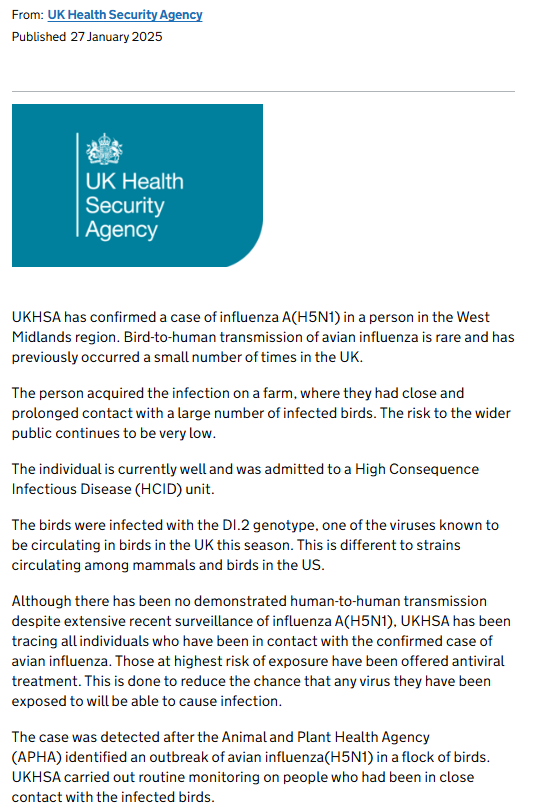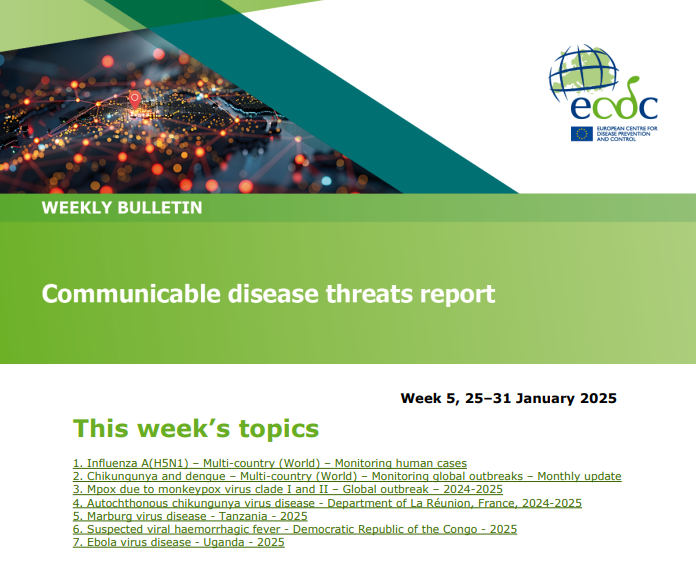We have another human H5N1 case in the U.K., where a person was infected with the virus directly from birds.
On January 27, 2025, the United Kingdom Health Security Agency (UKHSA) reported an H5N1 case in the West Midlands region. (Being curious, I consulted a map and found that this area is located in the middle western portion of the country, so the name seems appropriate.)

Source of exposure and H5N1 infection:
According to the UKHSA, this person had “close and prolonged contact with a large number of infected birds” on a farm. The report notes that the birds were infected with H5N1 clade 2.3.4.4b virus of the D1.2 genotype, which is “one of the viruses known to be circulating in birds in the UK this season.”
In good news, this person was doing well although hospitalized in a “high consequence infectious disease unit.”
No further details were provided as to the exposure, i.e., what exactly this person was doing when he or she came into contact with the infected flock, or even what type of birds they were.
It may be worth noting that earlier that month there was an H5N1 outbreak on a 1.4 million egg laying and rearing flock, also located in the area within the West Midlands. Since this human case apparently involves a “flock” rather than contact associated with a large commercial farm, I can’t say there’s a clear connection here, although it’s interesting to note the presence of the H5N1 virus in the same area. Additionally, H5N1 was reported on a commercial poultry farm on the eastern coast of the U.K. Another H5N1 outbreak was reported on a turkey farm further north on the eastern coast of the country. So the U.K. is dealing with a resurgence in poultry and backyard flock outbreaks, which hopefully don’t lead to a corresponding uptick in human cases.
Per the UKHSA statement, this case was detected after authorities identified H5N1 “in a flock of birds,” after which routine monitoring was done “on people who had been in close contact with the infected birds.” The statement does not state how many days this person was monitored before exhibiting any symptoms, or how many days after exposure there were prior to a positive test result. After confirming this case, contact tracing was performed and people of “highest risk” of exposure were offered antiviral treatment.
On January 31, 2025, in the ECDC weekly Communicable Disease Threat Report, we got a brief update on this human case.

Symptoms and Clinical Picture:
As to the nature of this person’s symptoms, the ECDC writes:
“The case experienced mild respiratory symptoms and irritated eyes. The individual is currently well and was admitted to a High Consequence Infectious Disease (HCID) unit for isolation.”
So we have a H5N1 human case exhibiting some form of mild respiratory symptoms and eye irritation after getting infected from a bird. That is good news and stands in stark contrast to the two recent severe human infections directly from birds in North America:
In December, a Louisiana man was infected with H5N1 genotype D1.1 from his backyard flock. He suffered severe disease and in early January, he died after being hospitalized. That case was the first severe infection, as well as the first death, in the United States, and the first known human case of H5N1 infection directly from backyard birds. A month earlier, in British Columbia, Canada, a teenage girl was hospitalized after infection with H5N1 genotype D1.1, although the exact route of her exposure remains unknown. She also suffered severe disease, and after a lengthy hospitalization she survived.
Hopefully there will be more details on the case from the U.K. and whether the mode of exposure or other details can shed light on why this case is mild while other human cases with the H5N1 strain from birds have been more severe, as compared to recent human cases infected from cattle.
No human to human transmission:
In a follow-up to the initial report that contact tracing had been conducted, the ECDC notes that efforts are ongoing. ECDC stated that “[o]ne symptomatic household contact has tested negative.”
So there does not appear to be any suggestion of human transmission here, although just what this contact was “symptomatic” with is unknown. Also unclear is the impact that antiviral use could have had on influencing a negative test result.

H5N1 Virus Genotype and Mutations:
Importantly, the ECDC report includes details about the genetic makeup of this H5N1 virus.
As already noted, this virus belongs to genotype D1.2, the same as the flock of birds. Analysis of the HA gene shows that it is “nearly identical to that of a strain collected 18 January 2025 from a chicken from the UK.” It is not clear where that sample was taken but it could have been from one of the earlier outbreaks noted above.
The report notes that one concerning mutation was found in the HA of this human virus: PB2 I292V. This mutation “is associated with increased polymerase activity in mammalian cell line and increased virulence in mice (tested on subtypes H10N8 and H9N2).” However, the ECDC cautioned that this is a “very common” mutation that is “also in strains isolated from birds.”
A study published in 2019 found that the PB2 I292V mutation in H9N2 viruses enhanced viral replication in mammalian cells and interfered with certain aspects of the innate immune response. Additionally, a different study published in 2019 found that the reverse of that mutation, PB2 V292I, weakened viral replication activity, thus showing the impact that mutations at this site have on viral replication in mammals.
Notably, the PB2 I292V mutation was one of several key mutations of concern discussed in a recent in-depth analysis on potentially adaptive mutations in recent H5N1 viruses. The report, titled Preparedness, prevention and control related to zoonotic avian influenza, was published by the ECDC on January 29, 2025. That report released a “short list” of mutations to look out for, and PB2 I292V is on that list.
What does this new case mean for the risk to humans?
It is concerning that one of the mutations “to watch” has popped up in this new H5N1 human virus. However, what the implications are for the presence of PB2 I292V remain to be studied. The ECDC noted that this mutation has been found in birds, although it has shown to be involved in improving mammalian adaptation during viral replication.
More broadly, consistent with the messaging from the CDC in the U.S., the ECDC maintains that the risk to the general public is still low. Obviously the risk is higher if you have a backyard flock of any kind, work at a commercial poultry or dairy farm, etc. Unfortunately there are scant details about how exactly this person was infected from this flock of birds, other than the existence of “close and prolonged” contact.
But what exactly does that mean? What did this person do that apparently increased their risk of contact with their flock of birds that ultimately resulted in a spillover infection? That is what we are missing from these reports, and what we have been missing from other prior instances. Without these facts it is difficult for people to evaluate their personal level of risk as this panzootic continues to increase in geographic scope and scale. So there still remains lots of unknown.
What we do know is every new human case is another opportunity for this bird flu virus to learn to adapt better to humans. And we don’t want that.
Until next time.
For more bird flu updates and research study analysis, be sure to read my other articles and follow me on social media.
Leave a comment below and join the discussion, and always feel free to reach out to me!



Your passion for your chosen topic is evident in every section. It’s contagious!
I adore your writing style. Thanks for sharing your interesting and insightful ideas.
I admire your skill to break down complex concepts into accessible parts. Well done!
GrbqvMcCSpOqgTixyqOMYmA